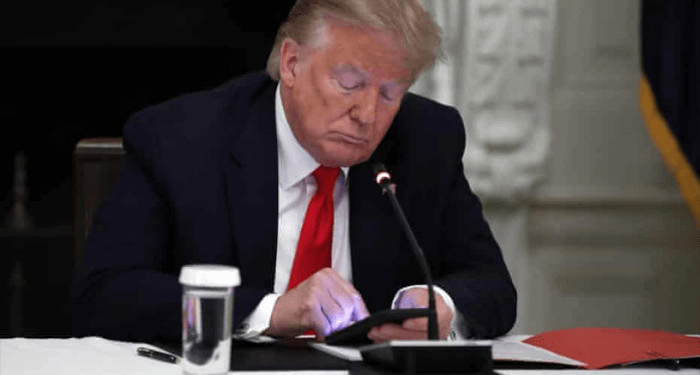* Dollar Also Rises
Oil prices rose by about $1 a barrel on Thursday after a U.S. court blocked most of President Donald Trump’s tariffs, while the market was watching out for potential new U.S. sanctions curbing Russian crude flows and an OPEC+ decision on hiking output in July.
Consequently, Brent crude futures climbed $1.03, or 1.6%, to $65.93 a barrel. U.S. West Texas Intermediate crude advanced by $1.06, or 1.7%, to $62.90 a barrel at 0630 GMT.
Also, the dollar rose against its major peers on Thursday after a court’s pronouncement, providing some relief for the currency that has struggled this year due to trade uncertainty.
The greenback gained a third of a percent against the yen and the Swiss franc but was off session highs after the trade court ruling that found Trump overstepped his authority by imposing across-the-board duties on imports from U.S. trading partners
READ ALSO:Emefiele Appeals Final Forfeiture Order On 753-Unit Housing Estate
A U.S. trade court on Wednesday ruled that Trump overstepped his authority by imposing across-the-board duties on imports from U.S. trading partners.
The court was not asked to address some industry-specific tariffs Trump has issued on automobiles, steel and aluminium using a different statute.
The ruling buoyed risk appetite across global markets which have been on edge about the impact of the levies on economic growth, but analysts said the relief may only be temporary given the Trump administration has said it will appeal.
“But for now, investors get a breather from the economic uncertainty they love to loathe,” said Matt Simpson, an analyst at City Index in Brisbane.
On the oil supply front, there are concerns about potential new sanctions on Russian crude. At the same time, the Organization of the Petroleum Exporting Countries and allies, together called OPEC+, could agree on Saturday to accelerate oil production hikes in July.
“We’re assuming the group will agree on another large supply increase of 411,000 barrels per day. We expect similar increases through until the end of the third quarter, as the group increases its focus on defending market share,” said ING analysts in a note.
Adding to supply risks, Chevron (CVX.N) has terminated its oil production and a number of other activities in Venezuela, after its key license was revoked by the Trump administration in March.
Venezuela in April cancelled cargoes scheduled to Chevron citing payment uncertainties related to U.S. sanctions. Chevron was exporting 290,000 barrels per day (bpd) of Venezuelan oil or over a third of the country’s total before that.
“From May through August, the data points to a constructive, bullish bias with liquids demand set to outpace supply,” Mukesh Sahdev, Global Head of Commodity Markets at Rystad Energy, said in a note, as he expects demand growth outpacing supply growth by 600,000 to 700,000 bpd.
Later on Thursday, investors will be watching for the weekly reports from the American Petroleum Institute (API) and the Energy Information Administration, the statistical arm of the U.S. Department of Energy.
According to the market sources familiar with the API data, U.S. crude and gasoline stocks fell last week while distillate inventories rose.
Meanwhile, a wildfire in the Canadian province of Alberta has prompted the temporary shutdown of some oil and gas production which could reduce supply, and forced residents of a small town to evacuate.
But, the Trump administration has filed an appeal within minutes.
“Reciprocal tariffs are off for now, but this should not alter the medium trend. Trump may find other methods to impose his economic and trade agenda, so in that respect it’s uncertainty squared,” said Kenneth Broux, head of corporate research FX and rates at Societe Generale.
“For some investors this is just an opportunity to diversify to non-dollar securities.”
U.S. assets including the dollar have been hurt in recent months as investors reassess historic assumptions around the strength of U.S. markets given an erratic trade policy and concern about high debt.
Advertisement · Scroll to continue
The dollar briefly hit a two-week high at 146.29 yen and was last trading 0.34% higher on the day at 145.23 yen . It was also 0.34% higher against the Swiss franc at 0.8296.
The euro slipped 0.13% to around $1.1276 and sterling was slightly weaker at around $1.3467. That left the dollar index , which measures the U.S. currency against six major peers, back above 100 for the first time in a week.
“There’s an initial reaction of a stronger dollar and weaker yen. However, considering judicial processes like appeals, I don’t expect a continuous rise in the dollar,” said Hirofumi Suzuki, chief FX strategist at SMBC.
Advertisement · Scroll to continue
The dollar index remains down 8% so far this year and analysts said that the new court ruling did little to offer clarity on the outlook for tariffs and they were sceptical of a sustained dollar rally in the face of a long court battle.
The greenback has weakened about 2% against the yen, nearly 6% against the Swiss franc and 4% against the euro since Trump slapped harsh levies on global economies on April 2, while the broader dollar index has fallen more than 3%.
Advertisement · Scroll to continue
U.S. Treasuries also sold off, with 10-year yields up 5 basis points at 4.53%.
Europe’s benchmark STOXX 600 (.STOXX), opens new tab index was up 0.3% in early trading, and U.S. stock futures jumped on a risk-on rally.
Global investor sentiment was also lifted this week after Trump delayed at the weekend his plan to impose 50% tariffs on European Union imports, and investors are on the lookout for any signs of improving relations between the United States and its trade partners.
Traders meanwhile cut their expectations for Federal Reserve interest rate cuts to 42 basis points of easing compared with 50 basis points earlier in the week, LSEG data showed.











